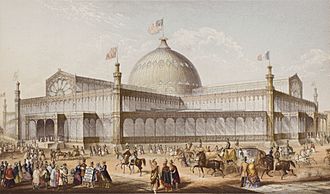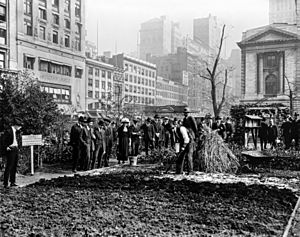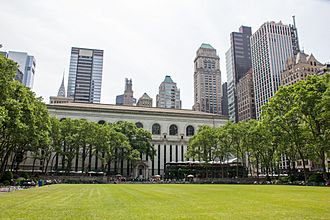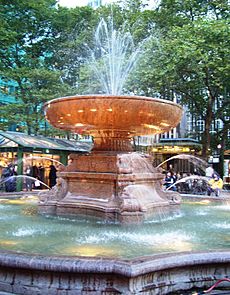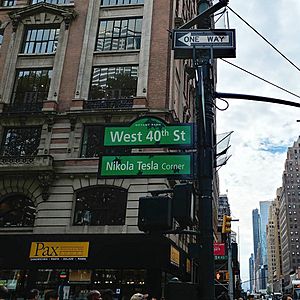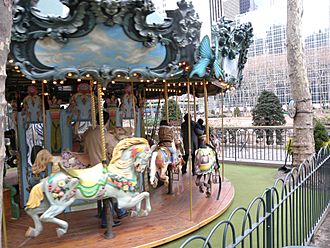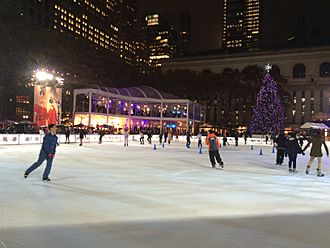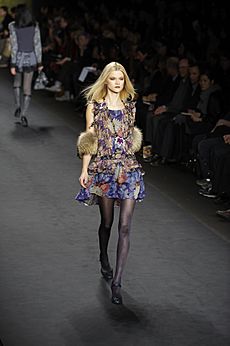Bryant Park facts for kids
Quick facts for kids Bryant Park |
|
|---|---|
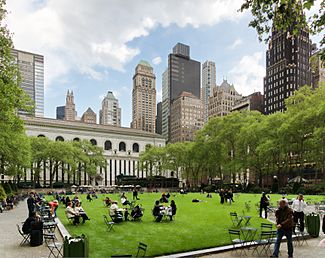
The lawn in Bryant Park, with the New York Public Library Main Branch in the background
|
|
| Type | Public park |
| Location | between Fifth and Sixth Avenues and between 40th and 42nd Streets in Midtown Manhattan, New York City |
| Area | 9.6 acres (3.9 ha) |
| Created | 1847 |
| Designer | Carrère and Hastings, Lusby Simpson |
| Etymology | Named for William Cullen Bryant |
| Operated by | New York City Department of Parks and Recreation |
| Status | Open all year |
| Awards | Design Merit Award from Landscape Architecture Magazine Urban Land Institute Award for Excellence (1996) |
| Public transit access | Subway: Bus: M1, M2, M3, M4, M5, M7, M42, M55, Q32 |
|
New York Public Library and Bryant Park
|
|
| Location | Avenue of the Americas, 5th Ave., 40th and 42nd Sts., New York, New York |
| Built | 1895 |
| Architect | Carrere & Hastings; Simpson, Lusby |
| Architectural style | Beaux Arts |
| NRHP reference No. | 66000547 |
| Significant dates | |
| Added to NRHP | October 15, 1966 |
Bryant Park is a 9.6-acre public park in Manhattan, New York City. It sits between Fifth Avenue and Sixth Avenue, and 40th and 42nd Streets. Even though the New York Public Library Main Branch is part of the park, it forms the park's eastern edge.
The western part of Bryant Park has a big lawn, shady paths, and fun things like a carousel. This area is actually built over underground storage for the library's books! The park hosts many events, including a "Winter Village" with an ice skating rink and shops during the colder months.
The first park here opened in 1847 and was called Reservoir Square. This was because it was close to the Croton Distributing Reservoir. The New York Crystal Palace was built here in 1853 for a big exhibition, but it burned down in 1858. In 1884, the square was renamed for journalist William Cullen Bryant. The reservoir was removed in 1900, and the New York Public Library's main building opened in 1911.
Bryant Park was rebuilt in 1933–1934. After a period of decline, it was restored again from 1988–1992. During this time, the park was improved, and the library's underground book storage was built.
Even though the New York City Department of Parks and Recreation owns it, a private group called the Bryant Park Corporation manages the park. This group was started in 1980 and helped bring the park back to life. Bryant Park is a great example of how public and private groups can work together. It is also a protected historic site.
Contents
What is Bryant Park Like?
Bryant Park is located between Fifth and Sixth Avenues and 40th and 42nd Streets. It covers about 9.6 acres. The New York Public Library Main Branch is on its eastern side. The park is mostly a quiet place for people to relax. It does not have sports fields.
The park is a few steps higher than the streets around it. Stone stairs help people get into the park from the sidewalks.
The Great Lawn
One of the park's biggest features is a large lawn. It is a bit lower than the paths around it. This lawn is a popular spot for office workers to eat lunch. It also hosts major events like Bryant Park Movie Nights and Broadway in Bryant Park. The lawn is open from February to October. Then, it closes to make way for the Bank of America Winter Village.
Walkways and Statues
Many paths surround the central lawn. The northern and southern sides have two flagstone walkways each. These paths are lined with London plane trees. These trees give the park a European feel.
Many statues are placed throughout the park. A raised area on the eastern side of the lawn has gray flagstones and red brick. The William Cullen Bryant Memorial is the main feature here.
Other Park Features
A building with restrooms is on the northern side of the park, along 42nd Street. A carousel, added in 2002, is on the park's southern side.
You can reach the park by New York City Subway at the 7 <7>, B D F M trains station. Entrances are on the northern and western sides. Many bus routes also serve the park.
History of Bryant Park
Early Days
In 1686, this area was a wilderness. New York's governor, Thomas Dongan, set it aside as a public space. George Washington's troops marched through here in 1776. The city bought the land in 1822. From 1823 to 1840, Bryant Park was a graveyard for the poor. Thousands of bodies were later moved to Wards Island.
The first park opened here in 1847. It was called "Reservoir Square" because of the Croton Distributing Reservoir nearby. In 1853, the New York Crystal Palace was built in the park for a big exhibition. This Crystal Palace burned down in 1858. The Latting Observatory was also built for the exhibition and burned down in 1856. The square was used for military drills during the American Civil War. It was also a site of unrest in July 1863.
Reservoir Square was updated in 1870–1871. Many new buildings were planned for the square but were never built.
Renaming and Library Building
In 1884, Reservoir Square was renamed Bryant Park. This honored William Cullen Bryant, a newspaper editor. Around the same time, plans for a library in Bryant Park began. The library would be built where the reservoir was. Some property owners wanted to keep the park open, but the reservoir was set to be removed.
When the New York Public Library (NYPL) started in 1895, its founders wanted a grand main building. They chose to build it at the eastern end of Bryant Park. This was a central spot between the Astor and Lenox Libraries. The architects, Carrère and Hastings, also planned a pedestrian area with a flower market. These plans were later canceled.
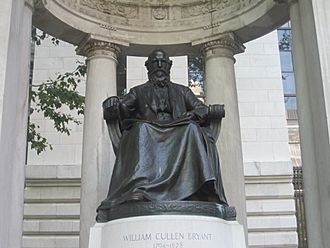
The reservoir was taken down by 1900. Construction on the library began. The park also got improvements like gardens and public facilities. Since the park was higher than the streets, a fence and wall were built around it. Benches were added along the walls. The park's inside was divided into three lawns. Four stone stairways were built for access. In 1910, 42nd Street was made wider. This meant moving the fence on the park's northern side. The NYPL's Main Branch opened on May 23, 1911.
Park Improvements and Transit
Because Bryant Park is in the middle of Midtown Manhattan, many transit lines were built around it. The first was the Sixth Avenue Elevated railway in 1878. The city's first subway line, now the 42nd Street Shuttle, opened in 1904. It ran under 42nd Street.
The Catskill Aqueduct water tunnel was built under Bryant Park in the early 1910s. After this work, the park was fixed up. During World War I, Bryant Park was used for patriotic events. A "war garden" and a building for soldiers were put in the park. After the war, an experimental garden was placed there.
During the building of the IRT Flushing Line in the 1920s, part of Bryant Park was closed for four years. The subway line was built right underneath. The subway tunnel was 35 feet underground. The Fifth Avenue station opened in 1926. The tunnel under Bryant Park to Times Square opened the next year. After the subway work, plans were made to restore the park's northern part.
1930s Restoration
By the 1930s, Bryant Park was not in good shape. The Sixth Avenue elevated train made it dark. Many plans were suggested to fix the park, but none happened. In 1933, a competition was held to redesign the park. Lusby Simpson won with his design.
In February 1934, under parks commissioner Robert Moses, work began on Simpson's plan. The new park had a large lawn, hedges, and an iron fence. Two new entrances were added from 40th and 42nd Streets. About 270 trees were planted. Workers from a government program helped with the project. The renovation was finished by late 1934, and the park reopened on September 15.
Parts of the park closed again in the late 1930s. This was because the elevated train was taken down, and a new subway line was built underground. The new subway opened in 1940.
What Can You See and Do?
Art and Statues
You can find many interesting statues in the park:
- Statue of William E. Dodge (1885): A standing figure on the park's northern side.
- William Cullen Bryant Memorial (1911): A statue of the park's namesake on the eastern side.
- Josephine Shaw Lowell Memorial Fountain (1913): This fountain is on the park's western side. It collects thousands of dollars in coins each year!
- Bust of Johann Wolfgang von Goethe (1932): A bust on the park's southern side.
- Statue of José Bonifácio de Andrada (1954): A standing figure in the park's southwest corner.
- Statue of Gertrude Stein (1992): A sitting figure in the park's southeast corner.
- Statue of Benito Juárez (2002): A standing figure in the park's northwest corner.
Other Memorials
The northwest corner of Bryant Park has Heiskell Plaza. This is a stairway and entrance area. It was named in 1993 for Andrew Heiskell, who helped start the Bryant Park Corporation.
The southwest corner of Bryant Park is called Nikola Tesla Corner. Tesla, a famous inventor, lived nearby. He used to feed pigeons in the park.
Carousel
Bryant Park has a carousel called Le Carrousel Magique. It is in the southern part of the park. The carousel was designed by Marvin Sylvor and installed in 2002. It is 22 feet wide and weighs 12,000 pounds. It has 14 animal figures, 12 of which move up and down. The carousel plays French music. It was updated in 2009. A ticket booth from 1928 was moved here from another park. As of August 2019, a ride costs $3.
Restrooms
Bryant Park has a beautiful granite restroom building on its northern side. These restrooms were built in 1911. They were closed in the 1960s but reopened in 1992 after being restored. They are known as some of the best restrooms in the city. They were renovated again in 2017. Now, they have rotating artworks, fresh flowers, classical music, and automatic toilets and faucets.
Reading Room
The original Reading Room started in August 1935. It was a place for unemployed people during the Great Depression to read and share ideas. It was very popular. Publishers donated books and magazines. The Reading Room stopped in 1944 due to World War II.
The Reading Room came back in 2003. Now, it has readings by writers, book clubs, and storytelling for kids.
Bank of America Winter Village
In 2002, Bryant Park started the Holiday Shops. This was to make the park lively in winter. In 2005, it became a bigger event with New York's only free-admission ice skating rink. The Winter Village also has a Christmas tree and places to eat.
Bank of America sponsors the Winter Village. It can be set up in just two weeks. It has made the park a popular place all year round. In 2016, Urbanspace became the new operator for the Holiday Shops. They grew from 80 shops in 2002 to over 170 in 2018.
Park Activities
Many events happen on the lawn at Bryant Park. Bryant Park Movie Nights are on summer Monday evenings. Free music shows are also held, like Broadway in Bryant Park. This features performers from Broadway musicals.
The park has activity areas open all day. You can play board games, chess, and backgammon. There is also a putting green, an Art Cart, and ping pong tables. You can take free classes in juggling, yoga, tai chi, and knitting. At Bryant Park Games, you can borrow games like Chinese chess and quoits.
You can buy food and drinks at four park kiosks. There are two more kiosks on Fifth Avenue.
Past Events
Bryant Park used to host New York Fashion Week (NYFW) shows. These shows took over the park for two weeks in winter and late summer. NYFW moved from Bryant Park in 2010 after disagreements with the park's management.
Protecting Bryant Park
Bryant Park and the New York Public Library Main Branch were listed on the National Register of Historic Places in 1966. This means they are important historic sites. In 1974, the New York City Landmarks Preservation Commission also named the park an official scenic landmark.
Images for kids
-
The lawn, facing west toward 1095 Avenue of the Americas (left) and Bank of America Tower (right)
-
The park from above, a bit of green amid Midtown Manhattan's buildings
See also
 In Spanish: Bryant Park para niños
In Spanish: Bryant Park para niños


